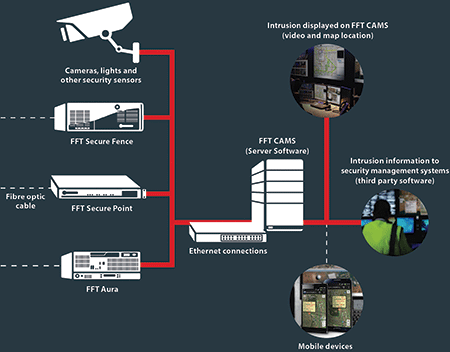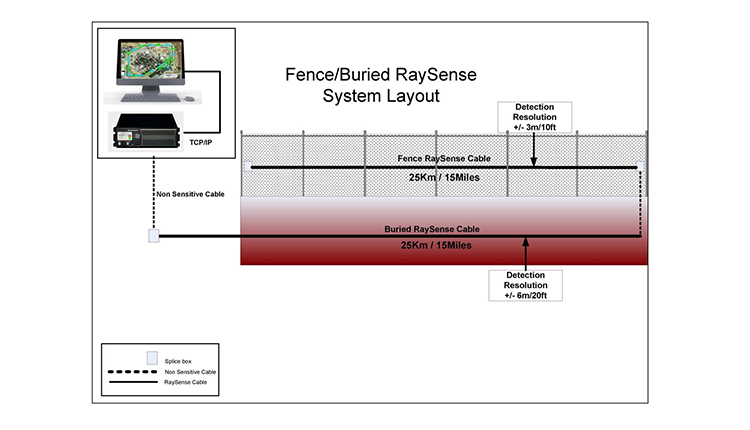Enhance Your Safety With Advanced Fiber Optic Security Equipments
In a period where safety is vital, advanced fiber optic protection systems present a compelling option for enhancing security throughout different settings. These systems not just flaunt exceptional data transfer and rate for high-resolution security yet also provide exceptional durability versus exterior interferences. As companies increasingly look for trusted methods to safeguard their possessions, the assimilation of cutting-edge technologies like AI and IoT within fiber optic structures elevates vital concerns about their performance contrasted to traditional systems. What implications do these improvements hold for future protection measures?
Benefits of Fiber Optic Protection
Taking advantage of the advantages of fiber optic technology dramatically enhances safety systems across various applications. One of the main advantages is the enhanced data transfer capability, permitting the transmission of big quantities of data at broadband. This is particularly vital for real-time video clip monitoring, where high-resolution feeds can be sent without latency, making certain prompt action capabilities.
In addition, fiber optics exhibit superior resistance to electro-magnetic disturbance, which is important in settings with potential signal disruptions. This reliability makes sure consistent performance in crucial safety and security procedures. Fiber optic wires are much less prone to tapping and unapproved accessibility compared to standard copper circuitry, consequently improving information honesty and confidentiality.
An additional notable advantage is the durability of fiber optic systems; they are much more resistant to environmental variables such as dampness, temperature variations, and destructive compounds. This resilience converts to lower maintenance prices and longer life expectancies for security installations.
Finally, the light-weight nature of fiber optic cables helps with easier setup and routing, specifically in complicated frameworks (fiber optic security system). Inevitably, the assimilation of fiber optic innovation into protection systems not only strengthens protection steps but likewise optimizes operational performance
Trick Features to Take Into Consideration
When examining fiber optic security systems, a number of crucial functions must be considered to make sure ideal efficiency and effectiveness. First, analyze the system's detection array and level of sensitivity; a considerable array enables keeping an eye on big locations, while high level of sensitivity guarantees that even minor disruptions are discovered immediately.
Following, think about the integration capabilities of the system. A fiber optic protection system should seamlessly user interface with existing safety procedures such as cameras and alarms, creating a natural safety network.
Resilience and environmental resistance are additionally vital attributes. Make certain that the system is designed to withstand rough climate condition and prospective physical risks, as this will prolong its operational life-span.

Last but not least, look into the scalability of the system. A durable fiber optic security system should be conveniently expanding to accommodate future demands without considerable overhauls. By thoroughly thinking about these functions, you can pick a fiber optic safety and security service that improves safety and security in your atmosphere.
Installation Refine Review
To efficiently execute a fiber optic protection system, a systematic installation process is crucial. This procedure starts with a detailed website evaluation to establish the certain protection requirements and to identify ideal places for fiber optic cables and protection tools. Following this evaluation, the installation group will create an in-depth strategy, including cable pathways, necessary equipment, and click to read compliance with neighborhood guidelines.
Next, the installment entails laying the fiber optic cords, ensuring they are protected from environmental aspects and physical damages. Correct handling techniques are vital, as fiber optic cables are delicate and can be quickly harmed. After the cabling is mounted, adapters and terminations are thoroughly completed to ensure signal integrity.
The subsequent stage includes mounting protection tools such as video cameras, motion detectors, and alarm systems, all integrated with the fiber optic network. Rigorous testing is carried out to verify that all parts are operating properly and to guarantee optimum efficiency.

Comparing Fiber Optic to Traditional Equipments
The evolution of safety modern technology has caused substantial developments in the contrast between fiber optic systems and typical copper-based systems. Fiber optic systems use light to transmit data, supplying exceptional transmission capacity and rate compared to their copper equivalents. This results in boosted data transmission capacities, making optical fiber excellent for high-resolution video security and real-time surveillance.
Additionally, fiber optic cable televisions are immune to electro-magnetic disturbance, lowering the possibility of signal destruction triggered by outside variables. This particular makes certain regular performance, also in challenging settings. On the other hand, conventional copper systems are extra at risk to disturbance, causing possible vulnerabilities in protection applications.
Longevity is another advantage of fiber optic systems. They are much less prone to harm from environmental aspects such as dampness and temperature level variations, which can endanger copper wiring. Fiber optics are lighter and thinner, enabling for less complicated installment and decreased physical footprint.
Nevertheless, standard systems have a tendency to have reduced preliminary costs, making them eye-catching for budget-conscious tasks. While fiber optic systems may require a greater in advance financial investment, their lasting benefits-- such as lower maintenance costs and higher dependability-- usually surpass the first expenditure, placing them as a superior option for modern safety needs.
Future Fads in Safety And Security Technology
Emerging patterns in additional hints safety modern technology are positioned to transform the landscape of monitoring and danger discovery - fiber optic security system. As organizations significantly deal with advanced threats, advancements such as man-made knowledge (AI) and machine learning (ML) are ending up being integral to security systems. These technologies enhance the ability of fiber optic systems by enabling real-time information evaluation, recognizing anomalies, and automating feedbacks to prospective breaches
In addition, the integration of the Internet of Things (IoT) is changing safety frameworks. IoT tools can offer thorough situational awareness and facilitate smooth interaction in between different safety and security elements. This interconnectedness permits much more effective tracking and faster event feedback times.
Biometric verification is likewise getting momentum, offering a greater degree of protection with unique physical features. As this innovation develops, it is most likely to be included into fiber optic systems for improved access control.
Verdict
Finally, progressed fiber optic protection systems stand for a substantial advancement in safety and security and more monitoring technology. Their premium bandwidth, resistance to disturbance, and durability promote trustworthy surveillance and information stability. As these systems integrate AI and IoT capacities, they boost the total safety and security structure, ensuring robust protection for possessions. The shift from standard systems to fiber optic solutions reflects a growing pattern in the direction of extra reliable and effective security actions in a significantly complex technical landscape.